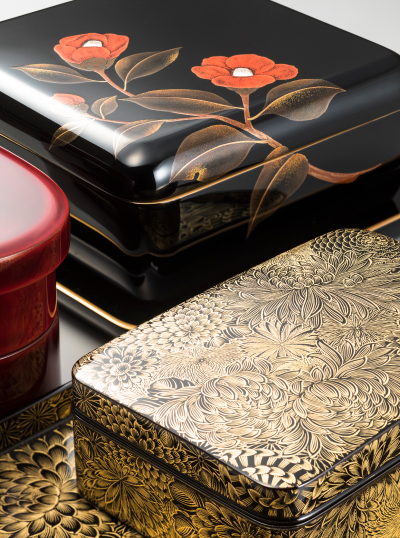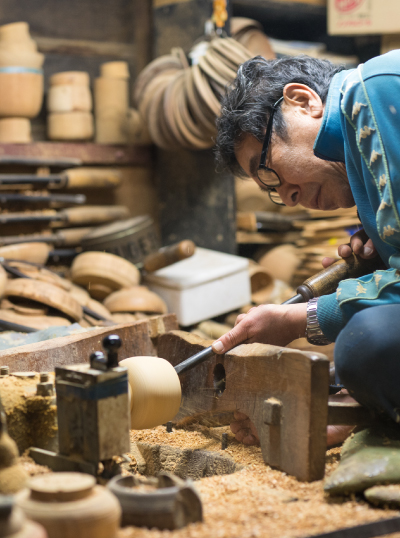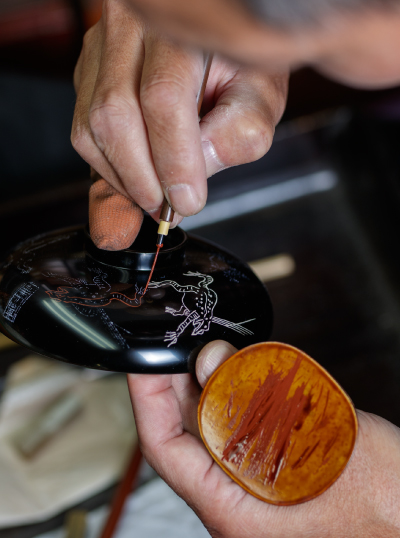Wajima-nuri has a long history. It is said that the oldest existing are the shunuri-tobira (door) located in the former main shrine building of Juzo Shrine, which was made in the Daiei 4 (1524), during the Muromachi era. In the early Edo era (1603-1867), today’s technique of Wajima-nuri had established, and its durability gained an excellent reputation. After that, decorativeness was desired as a gift for the imperial household. Therefore, chin-kin (submerged gold) began in the Kyoho era, the middle Edo period, and maki-e began in the Bunsei era, the late Edo period, and then finally today’s Wajimanuri finished up.
Features
One of the processes of Wajima-nuri is layering up the base made by mixing ki-urushi” (flesh urushi, which immediately after being taken), rice glue, and firing diatomaceous earth on the thick wooden base several times. This substantial effort supports the durability of Wajima-nuri. Moreover, there are several decoration procedures in Wajima-nuri. chin-kin which to carve a piece of art to lacquer and then a gold leaf or gold powder put on the art. maki-e which to paint the picture or characters by urushi and then create a piece of art by sprinkling gold, silver, color powder, and so on. Hence, high techniques and imagination are needed in every process.
“The definition of Wajima-nuri”
The definition of Wajima-nuri as provided by the “Act on the Promotion of Traditional Craft Industries”
The traditional technique
• The base paint is depending on the following technique and method.
• After painting the ki-urushi on the wooden base, move the process of “Kinuse” (sticking the cloth on the base to strengthen the base) by using cheesecloth or linen coated with the kisemono-urushi.
• To repeat the coating by the thing mixed ki-urushi, rice glue, and “Wajima- Jinoko” (It is a coarse powder from Wajima), and sharpening many times.
• In the top coating process, use the way of painting “Hana-nuri” or “Roiro-nuri” with refined urushi.
• In the process of decorating, it should be by chin-kin or maki-e.
• To use the following method in the process of making the wooden base.
• Regarding hikimono (turned articles such as bowls), to form with using rokuro (turntable) and rokuro-kanna (for shaping).
The material used traditionally
• To use natural urushi
• To use hiba, keyaki (zelkova), katura or hoonoki (magnolia), as well as same quality material of those.
The process of Wajima-nuri is categorized into the following three processes, “Kiji” (wooden base) forming the lacquerware by shaping wood which basically used for chopsticks, “Kyuu-urushi” painting urushi many times, and “Kasyoku” decorating with tyou-kin (metal carving) and maki-e for painted lacquerware. Moreover, through more than 124 stages, Wajima-nuri is commercialized.
Kiji
This process refers to cutting the original wood (unprocessed) into the shape of the products and carving it. In general, Nusiya and Kijiya, which engage in the process of wooden base, are separated, whereas both play an important role in making high-quality Wajima-nuri. There are several kinds of kiji (wooden base). For example, wan-kiji, sashimono-kiji such as jubako (lacquered box), and zen, magemono-kiji such as obon (tray), and hou-kiji such as a low table. There are expert craftsmen for each.
Kyuu-urushi
Regarding the painting process, Wajima-nuri is commercialized as standard products through the following three main processes, “Base Coating” (shitaji-tsukuri), “Internal Coating” (nakanuri), and “Top Coating” (uwanuri). The most important of the Wajima-nuri is base coating process. If come to think about building a house, not having a durable foundation will cause several problems in time. As same as lacquerware, it is impossible to make a good product without the amount of effort in the process. The process of base coating consists of “kinuse” (sticking the cloth on the base to strengthen the base), “jinuri” (painting base used by jinoko, which is a coarse powder from Wajima) and “togi” (shaping conducted every time after painting base. And then, through the internal coating (called nakanuri, which is painted well by nakanuri-urushi), and top coating (called uwanuri which finishes painting with the urushi of the highest quality), it finally gets close to the product. Ichimatsu is an exceptional Nushiya for the reason that taking the system of “All procedures are managed by one workshop” completing all the “kyuu-uruhi” process mentioned above in one workshop.

kasyoku
Kasyoku refers to the process of adding designability for products through the stage of chin-kin and maki-e on coated products. Craftsmen exist individually for each process, chin-kin, and maki-e. They add more value of durability to Wajima-nuri with each of their techniques, and they send their works which are products with originality or products following the requests of customers to the world. In particular, chin-kin is said that special techniques only in Wajima-nuri because it is impossible to carve by nomi (one of the tools for carving) without a thick base.
Copyright © 2022 Urushinoki All Rights Reserved




